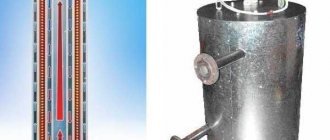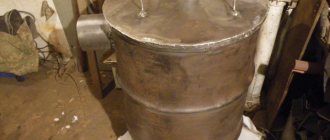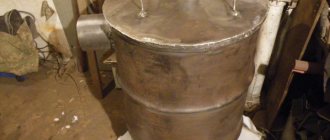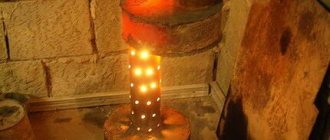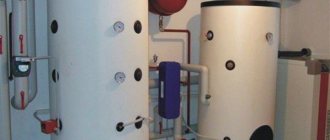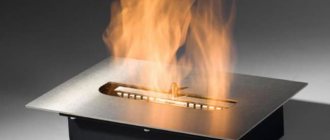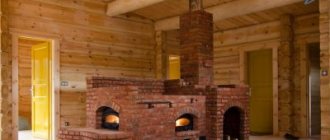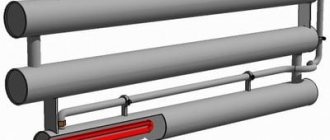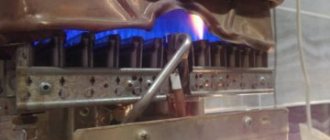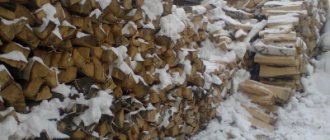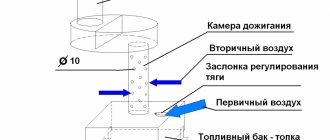Of all the heating equipment that is used today in everyday life, solid fuel boilers have been known for a long time. Due to the simplicity of their design and operating principle, and the availability of fuel, units of this type have become widespread. Today, for many residents of private houses in rural areas, such equipment has become a kind of “lifesaver.” The constantly rising price of household gas and difficulties in obtaining permits for the installation of a gas autonomous heater contribute to the fact that today, at a minimum, solid fuel boilers have not lost their demand among the population living near forested areas as a source of firewood.
Solid fuel heating boilers: on the left - mounted and operating, on the right - without connection to the circuit, at the installation stage.
Today, there are two options to solve the problem of autonomous heating using solid fuel: buy a ready-made factory product or make a solid fuel boiler with your own hands. The cost of a modern high-tech heating unit is quite high, but the price range is wide - from 3 to several tens of thousands of rubles, which makes the device accessible to a wide range of consumers.
If you have certain technical training, you can assemble a solid fuel boiler yourself, using diagrams and recommendations for making models of these devices, which are the most popular for DIY installation.
The main function of a heat exchanger for a boiler
In the heat exchanger, water is heated, which circulates in the system and transfers heat to the radiators.
Gas and air are supplied to the boiler burner for combustion. The gas burns, releasing heat, and the combustion products are discharged outside. The heat source in this case is a stationary element.
The coolant - water or antifreeze - enters the heat exchanger. This is a device that provides heat exchange between two environments with different temperatures. The latter is located in the combustion chamber above the burner. Water, moving through the heat exchanger, is heated and supplied to the heating pipes. Most often, the device takes the form of a set of plates or tubes. The larger its working surface, the better and faster the water heats up.
Do-it-yourself long-burning solid fuel boiler: video for review
Another option is to use a gas cylinder for the body. It can be used to create a completely effective design for heating small buildings. To get acquainted with the features of a homemade heating device, we suggest you look at the video. You can make a long-burning boiler with your own hands without drawings.
Appearance of a homemade structure with a heat exchanger
Material of manufacture
The heat exchanger for the boiler is made from durable materials that conduct heat well, are not prone to corrosion and are sufficiently resistant to pressure. Since the cost of the material also has to be taken into account, the choice is limited.
Steel
A steel heat exchanger is cheaper in price, but less durable.
This is the most affordable material. Steel is very strong, but can be processed well. The price is low. The advantage of this option is resistance to high temperatures. Steel is plastic and does not crack when heated, and does not deform even in areas in contact with the burner.
A steel heat exchanger for a solid fuel or gas boiler is prone to corrosion. Water inside the tubes and combustion products in the boiler chamber have a destructive effect on the material. This affects durability. The steel model weighs a lot, which leads to additional fuel consumption for heating the element itself.
The stainless steel heat exchanger is resistant to corrosion and lasts for at least 50 years.
Cast iron
The material is much more resistant to corrosion than steel, and is not afraid of rust and the action of acid anhydrides. The service life reaches 50 years. However, cast iron is a brittle alloy and can crack under the influence of temperature. To avoid damage, the cast iron tubular heat exchanger must be washed: if ordinary water is used, then once a year; if antifreeze - then once every 2 years; if distilled liquid - once every 4 years.
The weight of a cast iron element is even greater, so more fuel and time have to be spent on heating.
Copper
Copper is a noble metal that is not susceptible to any type of corrosion. It is chemically inert and tolerates pressure well. Copper conducts heat better, so less fuel is required to heat the element itself and the flowing liquid. The weight of the copper model is small, the dimensions are compact with a very developed working surface.
The disadvantage is the high price. Also, the copper heat exchanger is too sensitive to heating to high temperatures. More often found in boilers from foreign manufacturers.
Copper
Cast iron
Step-by-step production of a solid fuel boiler. Subtleties and nuances
You will not be able to make the most economical homemade solid fuel boiler, but you can create a heating apparatus that is quite suitable for heating and hot water supply. The fact is that the assembly of industrial products is carried out on high-precision industrial equipment from specially selected materials in compliance with technological parameters. Each factory boiler model is based on accurate thermal calculations. The possibilities of working at home are incomparably more modest than in industrial conditions, therefore, when choosing a model to be manufactured, one must proceed from existing realities, including one’s personal potential as an installer.
Tools and materials
Having a drawing and specification of the heating unit, you can determine the list of necessary tools. Whether you want to make a large boiler or plan to assemble a small solid fuel heating device for your dacha with your own hands, the list of accessories will be approximately the same.
Tool kit for self-production of a solid fuel heating unit
*
To work you will need the following tools and accessories:
- welding machine;
- small grinder with cutting and grinding discs (safety glasses);
- electric drill with metal drills;
- gas keys No. 1, 2;
- hammer;
- a set of open-end or ring wrenches and screwdrivers;
- pliers;
- 90 degree square
The main material in production is steel, the thickness of which for the boiler must be at least 5 mm, for grates - from 7 mm.
In addition, you will need:
- steel corner 50x50 - for the boiler frame;
- sheet stainless steel - if there is a storage tank in the design;
- thick-walled steel pipes with a diameter of 32-50 mm - for the manufacture of a coil heat exchanger.
A complete list of materials and their consumption is prepared in advance on the basis of technical drawings.
Manufacturing of the housing and heat exchanger
The boiler body, which often acts as a combustion chamber, is the basis of the entire structure. To reduce the deformation of the walls under the influence of high temperature, the enclosing structures of the firebox are made in two layers with a backfill between the layers of dry sifted sand, which plays the role of a geometry fixator. The outer and inner shells of the firebox are made of frames, which also increases the rigidity of the structure. In addition, to increase the strength of the combustion chamber wall, the outside can be sheathed with a steel angle or profile in the form of stiffening ribs.
Manufacturing a solid fuel boiler body by welding sheet steel blanks
On the front wall, using a grinder or a gas cutter, according to the drawing, two openings are cut out - for the hopper door and the ash pit.
Advice! Before cutting sheet steel, it is necessary to make fine markings of future openings with small diameter holes (3-4 mm) in the corners of the holes - this will allow cutting with greater accuracy.
After finishing cutting the sheet steel blanks and the profile for the housing, you can begin to create a heat exchanger. We use cut water pipes, which are connected by welding into a single sealed circuit. The main task is to create a sealed flow fragment of maximum length to increase the heating area of the pipe.
This video shows how to make a heat exchanger, correctly position the pipes and perform welding.
Assembly
Once all structural elements are ready, assembly begins, which is best done at the site where the unit is installed - sometimes the dimensions and weight of the finished device do not allow it to be moved from the assembly site to its final location.
Most often, the boiler is installed on a specially constructed concrete foundation with the unit fastened by welding to embedded parts - anchors. Installation begins with the installation of the frame, after which it is equipped with components and cladding sheets. All welded joints are made with chamfering and weld processing - slag removal and grinding.
Note: After assembling the housing, a thorough visual check of its tightness is performed, based on the results of which additional welding of the seams is performed.
Grate bars (steel grate) and a heat exchanger are installed in the finished housing, which is connected by welding to the heating circuit. During installation of the coil, it is important to fulfill the design angle of its inclination, otherwise obstacles will be created to the natural circulation of the coolant in the circuit.
The body of a solid fuel boiler at the stage of installing external stiffeners
Important! It is better to entrust the manufacture of a storage tank from stainless steel with its insertion into the circuit to professionals, since working with this material requires special equipment and practical skills.
Upon completion of assembly, the boiler is painted with two layers of heat-resistant paint with preliminary surface preparation to protect it from corrosion.
Heat-resistant paint Ecoterra for covering surfaces operating at high temperatures
A self-made heating boiler is durable and easy to maintain, which consists of periodically cleaning the firebox from ash and maintaining the chimney.
Classification of heat exchangers
Primary heat exchanger for the heating circuit in the form of a coil with plates
Gas boilers can perform several functions. The main thing is heating the home. However, dual-circuit models also heat water for various household needs: from washing dishes to the bathroom. It is on this basis that heat exchangers are distinguished.
Primary
Serves the heating system. It is a pipe with a fairly large diameter, bent in the form of a coil in one plane. To increase the working surface of the device, plates of different sizes are placed here.
The primary heat exchanger is subject to the highest loads. From the outside it is affected by combustion products - soot, dirt, acid anhydrides, from the inside - by salts dissolved in the coolant. To reduce wear, the part is coated with paint and treated with anti-corrosion compounds.
The best option is a heat exchanger made of stainless steel or copper, since it is not subject to rust and is not afraid of salt deposits.
Secondary
Secondary heat exchanger for hot water supply
This heat exchanger heats the liquid for hot water supply. Its heating temperature is lower, but it is not worth heating water for domestic needs above +60 C. Most often, this is a plate design: it is assembled from many plates with extruded passages through which tap water circulates. Multi-pass models are more effective, since within one plate the liquid changes direction several times, that is, it stays in it longer and warms up better. It is made from steel, copper, aluminum.
Bithermal
When clogged, bithermal heat exchangers must be replaced with new ones.
They consist of 2 pipes inserted into each other. The coolant moves through the inner one, and water for hot water flows through the outer one. The heating fluid is heated in the combustion chamber and partially transfers heat to water for domestic needs.
The design is much cheaper. But although the water here heats up faster, its volume is limited. In addition, the bithermic heat exchanger is very sensitive to water quality and gets dirty much faster. Cleaning the device is not enough. To prevent rapid clogging and failure, it is necessary to install water filters at the inlet.
It is not possible to clean a combined heat exchanger like a regular separate one. If there are large salt deposits or clogging, the element will have to be replaced.
Safety precautions
Strict compliance with all safety standards and regulations can guarantee durability, reliability and the absence of the threat of fires during operation of the heating system.
Compliance with all standards guarantees safety.
The boiler should be installed in the most suitable location, and for large rooms, a separate boiler room should be made.
Boiler operating rules:
- combustible and flammable materials cannot be located near the device;
- ventilation must be in good working order;
- Do not allow the water in the system to overheat or completely evaporate through the expansion tank.
The best option is to install the unit in a separate building. Firewood, coal and peat used as fuel will pollute the space next to the boiler, which is unacceptable in a residential building. And possible leakage of combustion products will not lead to dangerous consequences.
If the power of the heating system does not exceed 35 kW, its installation within the heated area is permissible. But in this case, it is advisable to fence off the device with a small brick wall.
Criterias of choice
The main parameter of a heat exchanger is its power.
When choosing a device, the purpose is taken into account - in this case it is heating the coolant, and the type of medium - steam, water, antifreeze. A gas boiler usually works with water, but there are exceptions.
Other selection criteria:
- Coolant temperature at the inlet and outlet - it is necessary to calculate how much heat the consumer should receive. Based on these data, the heat exchanger power is calculated.
- Allowable pressure losses - the water pressure decreases as it passes through the heat exchanger. If it falls too low, it will not be possible to create a column of hot water of sufficient height.
- The maximum operating temperature on the burner reaches 600–700 C. A cast iron and steel heat exchanger can withstand this temperature; copper heat exchangers can withstand this temperature with some difficulty. The aluminum model must not be used.
- Maximum operating pressure – does not limit the choice of design or material.
Dimensions are a significant parameter. With the same efficiency, a shell-and-tube heat exchanger occupies an area 3–4 times larger than a plate heat exchanger.
Let's start installation
The sequence of work depends on the design features of the heat exchanger.
Installation of a device with a register
When installing in an old furnace, you will have to dismantle part of the masonry. The sequence of work is as follows:
- We prepare the foundation for the coil right in the firebox cavity.
- We install the coil.
- We lay the disassembled row of bricks, leaving space for the inlet and outlet parts of the pipes.
- We connect the heat exchanger to the heating system.
Before use, the tank must be checked for leaks. You can make sure there are no leaks by filling it with water, preferably under pressure.
Installation of a device with a container
The best option for a stove or fireplace. Made from a metal tank and two copper tubes. The tank volume is usually about 20 liters. In the absence of a finished product, a tank of sufficient volume is made by hand by welding sheet steel.
For the manufacture of the heat exchanger, a material thicker than 2.5 mm should be used. Welding should be done in such a way that the thickness of the formed seam is minimal.
The tank must be installed 1 meter above the floor level, but no further than 3 meters from the stove. Two holes are made in the tank: one near the bottom, the second at the highest point on the opposite side. The efficiency of heat transfer depends on the location of the lines.
It is necessary to strive to ensure that the minimum deviation of the lower outlet in the direction of the floor is 2 degrees. The top one should be connected at a 20 degree angle in the opposite direction.
The drain valve is being installed in the storage tank. There is another tap designed to drain the entire system, which is installed at the lowest point. After checking the tightness, the system is ready for operation. The efficiency of such a stove with a heat exchanger can be appreciated in the cold season.
Correct operation
The heat exchanger is washed depending on the water hardness.
Transportation, installation and operation of the heat exchanger device are described in detail in the instructions:
- The heat exchanger is placed in the apparatus so that it has easy access for inspection and repair.
- Start-up is performed at stable pressure and temperature. Do not increase the temperature faster than 10 degrees per minute or increase the pressure more than 10 bar per hour.
- When filled with water, the air valves and valves behind the heat exchanger remain open. After the pump starts, they are closed. In this way, stable pressure is achieved.
- You need to change the heating parameters smoothly. The slower this happens, the longer the seals and the heat exchanger itself will last.
- The device needs to be cleaned periodically. The plate is cleaned directly in the frame, then the plates are removed and washed. Another method is possible: first removing and then cleaning the plates. It is not recommended to clean shell-and-tube machines. In case of complex blockages, the technician installs a plug.
- Before restarting, check the condition of all gaskets. Pressure and temperature are set as at 1st start.
To avoid salt deposits, a filter is placed on the water pipe in front of the boiler entrance.
Types of heat exchange
Now let's talk about the types of heat transfer - there are only three of them. Radiative - heat transfer due to radiation. As an example, you can remember sunbathing on the beach on a warm summer day. And such heat exchangers can even be found on the market (lamp air heaters). However, most often we buy oil or electric radiators to heat living quarters and rooms in an apartment. This is an example of another type of heat transfer - convection. Convection can be natural, forced (exhaust, and there is a recuperator in the box) or mechanically forced (with a fan, for example). The latter type is much more effective.
However, the most effective way to transfer heat is thermal conductivity, or, as it is also called, conduction (from the English conduction - “conductivity”). Any engineer planning to conduct a thermal calculation of a heat exchanger first of all thinks about choosing efficient equipment with minimal dimensions. And this can be achieved precisely due to thermal conductivity. An example of this is the most efficient TOA available today - plate heat exchangers. Plate TOA, according to definition, is a heat exchanger that transfers heat from one coolant to another through the wall separating them. The maximum possible contact area between two media, combined with correctly selected materials, plate profiles and their thickness, allows us to minimize the size of the selected equipment while maintaining the original technical characteristics required in the technological process.
Possible faults
Steel products are subject to corrosion and must be replaced.
Most problems require the intervention of specialists. Some can be eliminated by the user:
- Reduced pressure - if caused by contamination, it is enough to clean the heat exchanger. If the connection to the network is incorrect, you need to check the connection with the drawing in the instructions.
- Reduced efficiency - in case of mechanical contamination, the device is washed. If the reason is the accumulation of oil or substandard gases, additional devices are installed to remove them.
- Leakage - most often caused by decomposition of seals. They are being replaced.
- Mixing of working media - occurs when plates or tubes corrode. The plates can be partially replaced, but a new shell-and-tube heat exchanger will have to be installed.
While the warranty is valid, it is prohibited to open the heat exchanger yourself and carry out any repairs.
Popular manufacturers
Cast iron heat exchanger for Beleto floor-standing boiler
Heat exchangers are produced by many manufacturers. The most popular companies in 2022 were the following.
Navien
The largest Korean manufacturer. It produces products intended for household boilers. The advantage is resistance to low water quality and water hammer. The device is perfectly adapted to poor operating conditions.
Baxi
Italian manufacturer. Presents on the market wall-mounted and floor-mounted condensing boilers with a cast iron heat exchanger, as well as electric heaters.
The company makes primary heat exchangers from copper and brass. For secondary plates, stainless steel is used. This increases the cost of the products, but ensures maximum durability.
And others
There are other worthy manufacturers on the market:
- Fondital Victoria Compact is an Italian company. Offers high performance bithermic copper heat exchangers.
- Beleto is a well-known Russian plant that produces a variety of gas equipment. Manufactures steel, cast iron and copper heat exchangers of various types.
- Ariston - offers aluminum and copper heat exchangers. The materials are insensitive to corrosion, and the manufacturing technology guarantees their strength.
If there is a need to increase the efficiency of the boiler when replacing the device, consult a specialist to calculate the required parameters.
